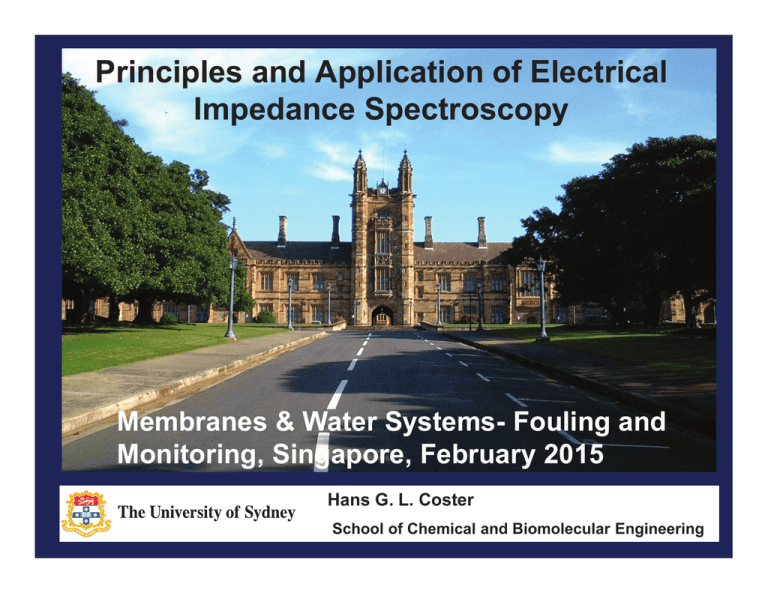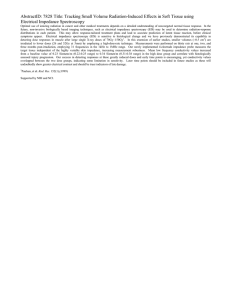Principles and Application of Electrical Impedance Spectroscopy
advertisement

Principles and Application of Electrical Impedance Spectroscopy Membranes & Water Systems- Fouling and Monitoring, Singapore, February 2015 Hans G. L. Coster School of Chemical and Biomolecular Engineering Membrane Dielectric Structure Skin Layer Sub layer What is involved in Impoedance Spectroscopy ? • Injection of sinusoidal AC currents through the membrane • Measurement of the current and voltage across the membrane • Measurement of the phase shift between the voltage & current Current voltage sample Contact solution/material Phase shift Sinewave signal generator Electrical Circuit Equivalents Impedance and Phase Phase Sine θ Capacitance, C = ω |z| current I V voltage V Impedance, |Z|= I Electrical representation of films Homogeneous film Film with 2 substructural layers C1 C G G1 d d1 C1= 0.006 F/m2 C2=0.059 F/m2 G1 = 0.003 S/m2 G2 =4.35 S/m2 C2 G2 d2 Capacitance dispersion with frequency This requires accurate determination of phase and impedance magnitude 0.0060 Capacitance – mF m-2 0.0059 J 0.0058 0.0057 J 0.0056 F J 0.0055 F F 0.1 1 10 100 Frequency - Hz 1000 Conductance dispersion with frequency This requires accurate determination of phase and impedance magnitude 0.040 0.035 J Conductance – S m-2 0.030 J 0.025 0.020 F F 0.015 J 0.010 0.005 F 0.1 1 10 100 Frequency - Hz 1000 Help to discern various processes and layers with different time constants Nyquist Plots J J J F F - Imaginary impedance F Real impedance additional arcs appear for each element with a different time constant EIS Membrane characteristics Fitted data Each dielectric element or transport process will have a characteristic electrical time-constant. These various elements/processes can be readily distinguished in a Nyguist plot of the imaginary vs the real impedance. Data for RO with NaCl 2000ppm and silica 200 ppm, crossflow 0.15 m/s: from Ho, Sim, Gu, Webster, Fane & Coster. (2015) -Imaginary Impedance (Ohms.m2) 0.5 ůĞŵĞŶƚϭ͗^ŽůƵƚŝŽŶ ůĞŵĞŶƚϮ͗DĞŵďƌĂŶĞƐƵďƐƚƌĂƚĞ ůĞŵĞŶƚϯ͗DĞŵďƌĂŶĞƐŬŝŶ ůĞŵĞŶƚϰ͗DĞŵďƌĂŶĞƐŬŝŶ ůĞŵĞŶƚϱ͗ŝĨĨƵƐŝŽŶƉŽůĂƌŝnjĂƚŝŽŶůĂLJĞƌ ůĞŵĞŶƚϲ͗ŝĨĨƵƐŝŽŶƉŽůĂƌŝnjĂƚŝŽŶůĂLJĞƌ 0.4 0.3 Fitting of EIS Data Fitting ƌŽƐƐͲƐĞĐƚŝŽŶĂůŽĨZK ;tͲϯϬͿŵĞŵďƌĂŶĞ 0.2 0.1 0 0 0.1 0.2 0.3 0.4 Real Impedance (Ohms.m2) ϭ 0.5 Ϯ Conducta Capacitance, ϲ ϰ ϱ Frequency, Elements nce, Gn(Ȧ) Cn (Ȧ)ϯ (F/m2) Ȧ (Hz) 2 (S/m ) n=1 n=2 n=3 n=4 n=5 12.4 5.79 35.3 21.1 15.4 4.124 x 10-7 2.41 x 10-6 2.53 x 10-3 4.34 x 10-2 0.26 4.792 x 106 3.83 x 105 2.22 x 103 77.1 9.32 n=6 14.6 3.1 <1Hz DĞŵďƌĂŶĞ ƚŚŝĐŬŶĞƐƐΕ ϭϱϬƵŵ dielectric constant, İ į (m) 78 36 5 5 78 78 1.67 x 10-3 1.32 x 10-4 1.75 x 10-8 1.02 x 10-9 2.66 x 10-9 2.23 x 10-10 Data from Wang, Sim, Gu, Coster & Fane J. Mem Sci Non-linear Effects: Concentration polarization membrane Build up in time of solute at surface Pressure driven flux + - Build up and depletion in time of ionic solutes at surface Electrically driven transport of ionic solutes AC Effects + - - + With AC currents, the profiles undergo an inversion during each cycle At low frequencies the concentration polarization will be much larger than at high frequencies of the AC. At very high frequencies there is insufficient time for concentration polarization to manifest Impedance Monitoring Cross-flow Module Cross section of module Voltage electrodes Current injecting plate electrodes An Impedance Cross-flow Module for monitoring membrane fouling in situ Insulating spacers and gasket Pressure plate Membrane Chamb plates/c electrod Membrane Signatures in early stages of Filtration 5 hrs silica 2 hrs Silica TMP (bar) Saline – no silica 25 20 15 10 5 0 Wang, Sim, Gu, Coster & Fane J Mem Sci 20 40 Time (hour) 60 Initial stages of filtration Concentration polarization and surface accumulation Data from Wang, Sim, Gu, Coster & Fane J. Mem Sci Signatures of Membrane Fouling 5 hrs silica 15 hrs silica TMP (bar) 48 hrs silica 25 20 Cake enhanced 15 concentration polarization 10 The EIS signatures changed well ahead of fouling revealed by TMP Data from Wang, Sim, Gu, Coster & Fane J. Mem Sci 5 0 20 40 Time (hour) 60 Signatures of fouling Cake formation The impedance signatures for fouling with Inorganics (eg silica) are very different from those with organic foulants. ^ŝůŝĐĂĨŽƵůŝŶŐ͗^ƵŐŐĞƐƚĞĚĨŽƵůŝŶŐ ŵĞĐŚĂŶŝƐŵ • Shift to the right in the Nyquist plots: slow built up of the silica layer on the membrane surface; Conductance in the concentration polarization layer drops. • Shift to the left: Impact of the cake enhanced concentration polarization (CECP) effect; The increased concentration polarization of NaCl at the membrane surface increases the overall conductance. More NaCl permeates through the membrane which shows up in a decrease in rejection. 20 Locating a “Canary” Membrane Fouling Monitor in Water Treatment Plants ƌŝŶĞ ;ƐůƵĚŐĞͿ EIS Fouling Monitor &ĞĞĚ EIS Fouling Monitor WĞƌŵĞĂƚĞ WƌŽĚƵĐƚ Collaborators SMTC, NTU A.G. Fane L. N. Sim Z.J. Wang C. Tang Jia Shin J. Gu W. Lo A. Yeo Chemical Eng., USYD T. Chilcott J. Kavanagh G. Barton J. Cien S. Hussain T. Handelsman UNESCO CMST, UNSW G. Leslie A. Anthony Yuang Wang Siao Yien Yeo INPHAZE, Pty Ltd Sydney M. Darestani D. Wang T. Kausmann
